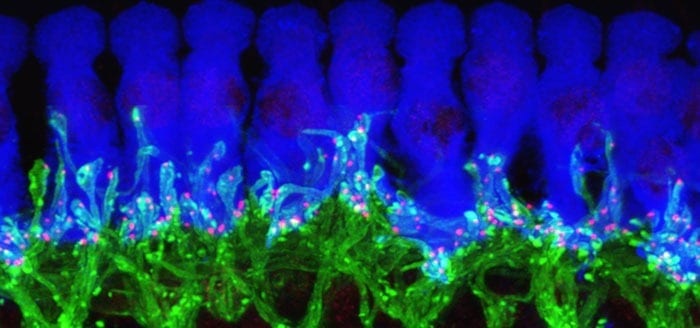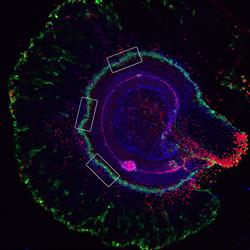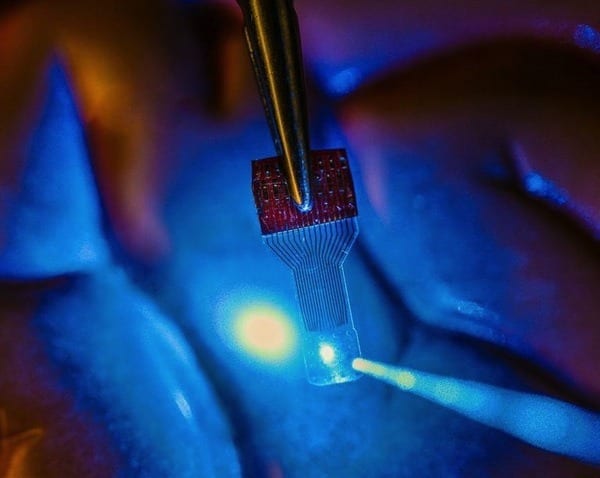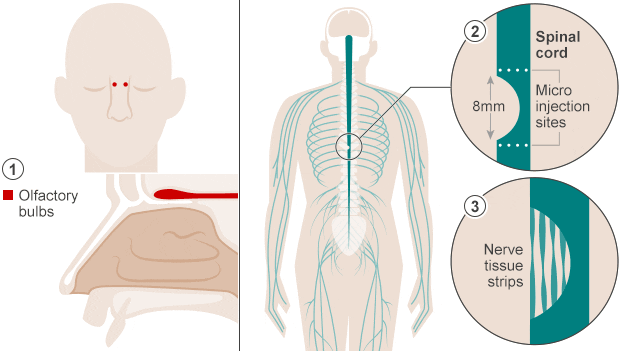
This microscope image of tissue from deep inside a normal mouse ear shows how ribbon synapses (red) form the connections between the hair cells of the inner ear (blue) and the tips of nerve cells (green) that connect to the brain.
Scientists have restored the hearing of mice partly deafened by noise, using advanced tools to boost the production of a key protein in their ears.
By demonstrating the importance of the protein, called NT3, in maintaining communication between the ears and brain, these new findings pave the way for research in humans that could improve treatment of hearing loss caused by noise exposure and normal aging.
In a new paper in the online journal eLife, the team from the University of Michigan Medical School’s Kresge Hearing Research Institute and Harvard University report the results of their work to understand NT3’s role in the inner ear, and the impact of increased NT3 production on hearing after a noise exposure.
Their work also illustrates the key role of cells that have traditionally been seen as the “supporting actors” of the ear-brain connection. Called supporting cells, they form a physical base for the hearing system’s “stars”: the hair cells in the ear that interact directly with the nerves that carry sound signals to the brain. This new research identifies the critical role of these supporting cells along with the NT3 molecules that they produce.
NT3 is crucial to the body’s ability to form and maintain connections between hair cells and nerve cells, the researchers demonstrate. This special type of connection, called a ribbon synapse, allows extra-rapid communication of signals that travel back and forth across tiny gaps between the two types of cells.
“It has become apparent that hearing loss due to damaged ribbon synapses is a very common and challenging problem, whether it’s due to noise or normal aging,” says Gabriel Corfas, Ph.D., who led the team and directs the U-M institute. “We began this work 15 years ago to answer very basic questions about the inner ear, and now we have been able to restore hearing after partial deafening with noise, a common problem for people. It’s very exciting.”
Using a special genetic technique, the researchers made it possible for some mice to produce additional NT3 in cells of specific areas of the inner ear after they were exposed to noise loud enough to reduce hearing. Mice with extra NT3 regained their ability to hear much better than the control mice.
Now, says Corfas, his team will explore the role of NT3 in human ears, and seek drugs that might boost NT3 action or production. While the use of such drugs in humans could be several years away, the new discovery gives them a specific target to pursue.
The Latest on: Hearing loss
[google_news title=”” keyword=”hearing loss” num_posts=”10″ blurb_length=”0″ show_thumb=”left”]
via Google News
The Latest on: Hearing loss
- New study finds using hearing aids can reduce risk of death by nearly 25%on May 7, 2024 at 8:38 pm
Researchers hope their findings will inspire action to make hearing aid devices more affordable since they can cost over $1,000 per ear.
- Free healthy hearing event at Northwestern on May 10 raises awareness for hearing losson May 7, 2024 at 3:59 pm
Hearing Month. To raise awareness about hearing problems, Northwestern University Center for Audiology, Speech, Language, ...
- Better Speech and Hearing Month| Local resources available for those experiencing hearing losson May 7, 2024 at 6:36 am
The Deaf and Hard of Hearing Center is hosting an Open House event Friday from 10 a.m.-2 p.m., where the public can learn more about available resources.
- Affordability, stigmas still barrier for people suffering from hearing losson May 6, 2024 at 11:28 pm
In this Better Hearing Month, East Texas sisters share obstacles faced in the hearing loss journey and process to finally getting help ...
- Police officers 'preparing legal action' over firework-related hearing losson May 6, 2024 at 6:00 pm
1919 Magazine reports that the force bought around 10,000 sets of sound suppressors – designed to protect against noise-induced hearing loss while still allowing officers to hear conversations and ...
- Do hearing aids cause tinnitus?on May 6, 2024 at 10:43 am
Let's cut to the chase: No, hearing aids in now way cause tinnitus. In fact, hearing aids are often prescribed as a form of treatment for tinnitus, which sometimes presents alongside hearing loss.
- Ross’ story: Being a dad-of-two with hearing losson May 6, 2024 at 3:08 am
It's #DeafAwarenessWeek, so we spoke to Ross, a father-of-two from Northern Ireland who has hearing loss. He talks about the struggles, from doctor's appointments to swimming pools, and why he's ...
- Losing the ability to hear birdsong can be the first sign of hearing losson May 4, 2024 at 11:24 am
Caroline Fitton started suffering from tinnitus in her mid-40s and she later went on to lose 40 per cent of her hearing. Now, Caroline talks about the tell-tale signs and how wearing a hearing aid dra ...
- Hearing loss now being seen in young people, including teenson May 2, 2024 at 12:58 pm
As the season of outdoor events kicked off, doctors had an important warning about hearing protection. Hearing loss is now being seen in young people, including ...
- New hearing guidelines aim to expand detection while promoting treatment, accesson May 1, 2024 at 9:36 pm
The American Academy of Otolaryngology – Head and Neck Surgery Foundation (AAO-HNSF) this week published updated guidelines on age-related hearing loss. Among the guidelines: Everyone 50 and up should ...
via Bing News










